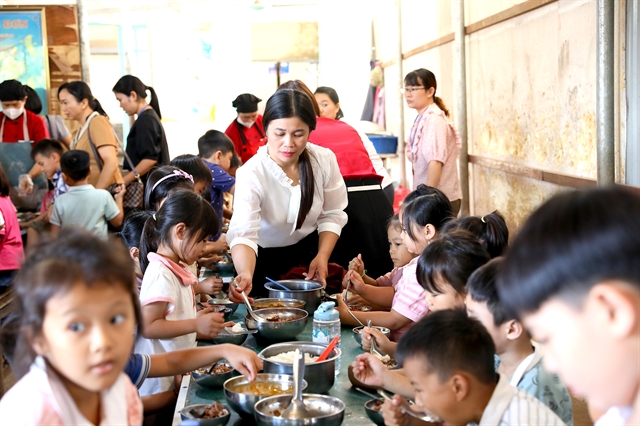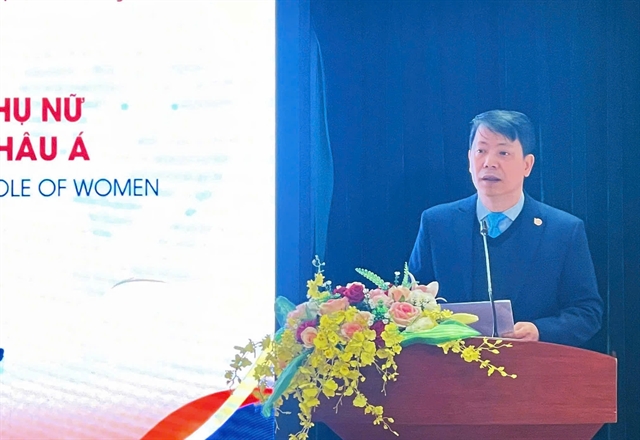 Society
Society

 |
| Teachers care for pupils during mealtime at Trần Văn Thọ Semi-boarding Primary School for Ethnic Minorities in Mường Nhé District, Điện Biên Province. — VNA/VNA Photo |
HÀ NỘI — Việt Nam has achieved significant progress in improving child nutrition over the past decade, with sharp declines in malnutrition and micronutrient deficiencies.
However, experts caution that disparities between regions remain wide and that school-aged children are increasingly facing the dual challenges of undernutrition and rising obesity.
According to the National Institute of Nutrition, the rate of underweight children under five years old fell from 17.5 per cent in 2010 to 11.5 per cent in 2020, and continued to drop to 10.4 per cent in 2024. Stunting declined from 29.3 per cent in 2010 to 18.1 per cent last year.
UNICEF said this is an impressive achievement, noting that Việt Nam met its Millennium Development Goal on nutrition seven years ahead of schedule.
Micronutrient indicators have also improved. Anaemia among children under five decreased from 27.8 per cent in 2015 to 19.6 per cent in 2020, while vitamin A deficiency dropped from 13.1 per cent to 9.5 per cent.
Health experts attribute these results to consistent Government strategies, noting that since 2001 Việt Nam has rolled out three national nutrition strategies with clear targets to 2030. Under these strategies, nutrition goals were integrated into socio-economic plans while implementing nationwide programmes from maternal and child care to micronutrient supplementation.
Expanded international cooperation and support from communities and businesses have driven progress, with specialists noting that investing in nutrition, especially in the first 1,000 days, can deliver economic returns many times greater than the costs.
Persistent challenges
Despite these improvements, disparities remain serious.
In 2023, stunting among children under five reached 37.4 per cent in the northern mountains, 28.8 per cent in the Central Highlands and 40.4 per cent in poor communes. Zinc deficiency continues to affect more than half of children and over 63 per cent of pregnant women.
Việt Nam has made real progress, but nutritional gaps between regions remain very large, said Associate Professor Trần Thanh Dương, Director of the National Institute of Nutrition.
He pointed to limited budgets, inconsistent implementation and gaps in awareness among local health workers as key reasons why programmes are not reaching all communities.
Many interventions are small scale, not sustained, and especially limited in disadvantaged and mountainous areas, he said.
Meanwhile, new problems are emerging. Rates of overweight and obese schoolchildren are on the rise, particularly in major cities.
Experts said that school canteens often lack diverse menus, while unhealthy snacks and sugary drinks are widely sold around schools.
School meals remain underfunded and heavily dependent on parental contributions, creating inequalities between regions. Most schools also lack trained nutrition staff, and coordination among ministries remains inconsistent.
During the 2020–2021 academic year, the Ministry of Education and Training in collaboration with the Ministry of Health piloted school nutrition programmes in 10 provinces. These combined balanced meals with nutrition education and physical activity. Results showed clear improvements in children’s height, weight and nutritional awareness.
Yet coverage remains limited. Only 47.7 per cent of kindergartens and just over 30 per cent of primary schools provide meals. In remote areas, facilities are inadequate, food safety standards are uneven and menus are often monotonous.
International experts have called for stronger policies.
Professor Nakamura Teiji, president of the Japan Dietetic Association, said Japan treats school lunches as part of education, teaching children not only about nutrition but also about food production, gratitude and environmental awareness.
Associate Professor Zhuifeng Guo from China’s National Health Industry Management Association stressed the importance of a strong legal framework and sustainable financing. He suggested Việt Nam consider a dedicated national school nutrition fund combining State budgets with support from businesses and communities.
Dr Philipp Rösler, former German Vice Chancellor, suggested Việt Nam draw on German and EU experience to boost children’s health.
He recommended a school milk programme using domestic fresh milk, national nutrition standards for school meals and scaling up successful pilot models.
The former vice chancellor also proposed school gardens linked with nutrition education and a school nutrition quality labelling system with regular monitoring to improve programmes. — VNS




